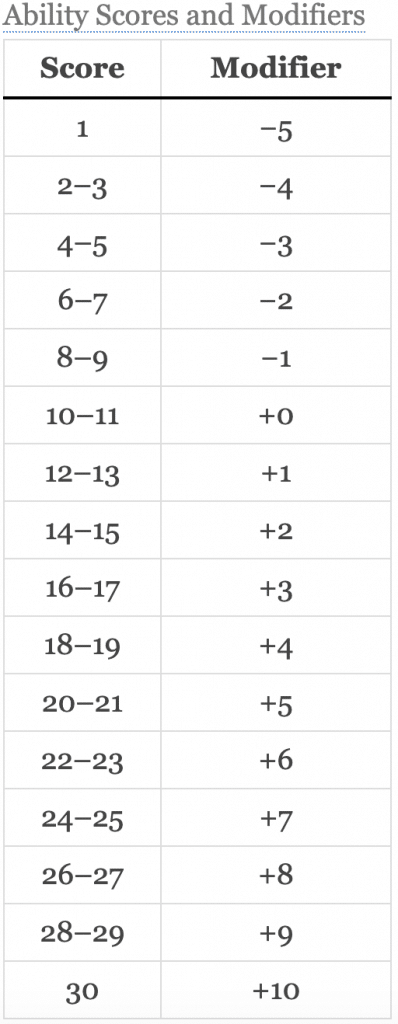What Are Ability Scores In D&D?
Ability scores in D&D are a quick description to describe a creature’s physical and mental stats. These are summed up as six abilities: Strength, Dexterity, Constitution. Intelligence, Wisdom, and Charisma. Through these stats, all actions can be determined. To help in understanding how to use each stat. Here is a fun explanation using fruit salad and tomatoes.
Strength is the ability to crush a tomato.
Dexterity is the ability to dodge a tomato being thrown at you.
Constitution is the ability to eat rotten tomatoes and not get sick.
Intelligence is knowing that a tomato is a fruit.
Wisdom is knowing NOT to put a tomato in a fruit salad.
Charisma is being able to sell a tomato-based fruit salad.
Ability scores are shown in two different ways: their score and their modifier. A creature’s ability score is their power level. If a creature has a high ability score in D&D, then they are considered more powerful. Meanwhile, a creature’s ability modifier is the creature’s effectiveness with that stat. The two work interchangeably with a higher ability score leading to a higher modifier. For example, a 10 is considered an average creature’s score. Thus, if a creature has an ability score of 10, their modifier would be +0. However, a creature with an ability score of 20 will get +5 to their ability modifier.
Notice, how the ability score went up ten points, but the ability modifier only went up 5? That is because the rule of thumb is for every two points increase in an ability score, the ability modifier goes up 1. To help with how the two work together, you can see a chart with every current D&D ability score and modifier used in the game below.

How Do You Determine Ability Scores?
Now that you know what ability scores for D&D are, the question becomes “how do you determine D&D ability scores?” There are two ways: Point buy system & roll system.
A D&D Point buy system is considered the fairest way to implement stats. The reasoning is that it lets every player build their character how they want. All the while, making sure all players have stats that are close to each other. How it is done, is you start out with every character having base stats of 8. From there each player has 27 player points to give their character. You can increase an ability score by 1 point for every 1 player point used. That is until an ability score gets to 13 for a stat. Then, the cost increases to two player points per ability score increase and maxes out at 15.
Don’t worry if the math is confusing. Just remember that abilities can only go up to 15 but no lower than 8. And, to raise abilities, it costs 1 point per increase raising to two player points per increase for 14 & 15 ability scores. If that is still confusing then I suggest this D&D Point Buy Calculator that is great for using the Point Buy System.
Meanwhile, the roll system is considered the easiest to implement. The roll system, states to use four d6 dice and roll. Take the highest 3 and that is you ability score. Do this 6 times (1 for each stat) and place them in the desired spot. Simple as that.
What Is An Ability Score Improvement?
Once you roll or buy your stats, some of you may desire to raise them. Luckily D&D planned for that. Depending on your class each one will receive an ASI (otherwise known as an ability score improvement) depending on your level. A fighter receives 7 ASI, a rogue 5, and all other classes 4.
An ASI happens roughly every 4 levels for all classes but fighter and rogue. What an ability score improvement allows you to do is: (1) increase an ability score by 2, (2) increase two separate ability scores by 1, or (3) choose a feat for your character. Now a two-point ability score increase seems like the best choice for a +1 increase in ability modifier. However, a one-point stat increase can also be desirable for those with odd number ability scores, such as 13 and 15. By choosing this option you can increase two scores to an even number. Thus, allowing you to increase two separate ability modifiers by 1 instead of one ability modifier. Usually, this is done after a character’s primary stat has reached 20.
The last option, feats, is an article of its’ own. However, to summarize, feats are abilities players can unlock in exchange for an ASI that enhances a character’s playstyle. An example of this is the Great Weapon Master feat. If a person prefers using two-handed weapons and already has a high strength ability score, then many players will choose this feat for their ASI. This feat effectively allows you to sacrifice accuracy for more damage making you more powerful. Therefore, instead of improving a stat, they chose a feat to improve damage. For a full review of feats, I recommend this article by flutes loot. It does a great job summarizing and explaining the feat system.
What Is An Ability Check v Skill Check?
Once you understand how to find your ability score in D&D, a question that gets asked is, “what is the difference between an ability check and a skill check?” The reason this question gets asked a lot is due to the nature of ability scores being involved in every aspect of your character. Put simply, an ability check is used for the broad application of a stat. Meanwhile, a skill check is used for a specific application. In D&D there is a list of skills that players can learn in several different ways. If a character learns the skill, then they are considered proficient. Being proficient in a skill will net you an increase to your effectiveness in the stat (aka ability modifier). If they have not learned the skill then they can only use their ability modifier when determining how well they do it.
For example, say a party member wishes to discern what kind of creature is locked in the dungeon. A dungeon master might ask them to use the “nature skill” to see if they can figure out which race it is. Now, suppose the creature started to speak and no one knew what it said. Then a dungeon master might ask them to make an intelligence check to figure out what they said since there is no skill for interpreting language. In this sense, the dungeon master called for a skill check to be used since there was a skill for it. However, the dungeon master called for an ability check when there was no skill that fits into what the player was trying to accomplish. As such, the general rule of thumb is, “if a skill can be used call for a skill check, if not use an ability check.”
Conclusion
By now, you should understand what an ability score is, how to determine your ability score, and how to use and increase your ability score. To summarize, an ability score is a creature’s power level for a certain stat. While the ability score for a player is determined via the point buy system or the roll system. From there, your ability score can increase roughly every four levels and can be called for in situations like ability checks. With this most ability score, modifier and check questions should be answered. Meaning, you have become an expert on ability scores, Congratulations! If you want to keep up the learning, then I suggest watching this article on advantages and disadvantages I wrote. It is great for explaining how the mechanic works as well as some of the math behind it. Useful for DM’s and players alike

